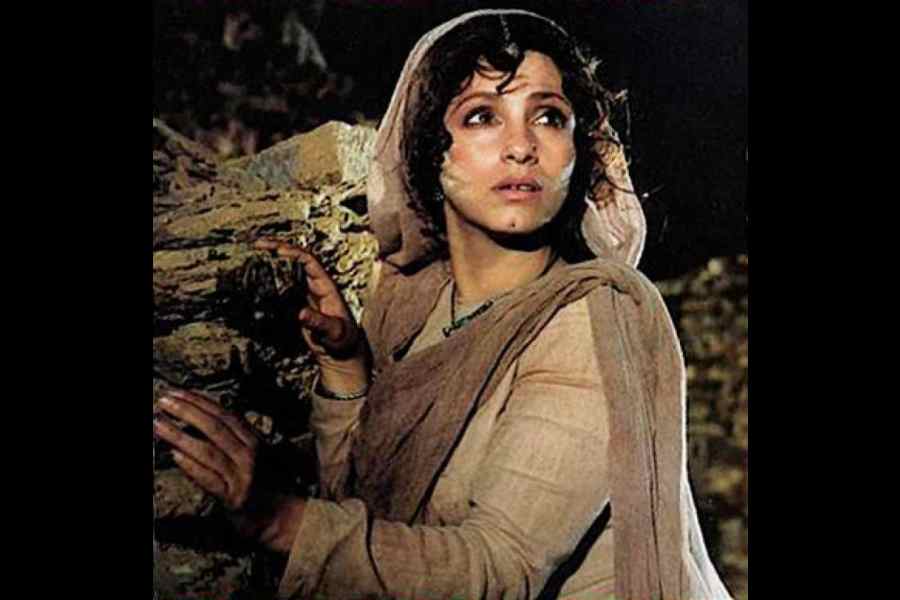Rabindranath Tagore’s short story, “Kshudhita Pashan” (Hungry Stones), and its subsequent cinematic adaptations by Tapan Sinha (Kshudhita Pashan, 1960) and Gulzar (Lekin, 1991) remind us how a simple distinction between the past and the present does not always work. The past is not something that has gone away forever as history; neither is the present merely about the here and now. This strange overlapping of time should not be rejected entirely as irrational thinking; we do not need to take refuge in the mystic world of supernatural powers to explain these phenomena either.
There are three overlapping tales in “Kshudhita Pashan” — a young traveller’s description of an event when he meets a strange, talkative, old man during a train journey; the old man’s account of a haunted palace; and, finally, an untold story of a young slave woman, which is intentionally left vague and imprecise.
Let us begin with the master narrative: a young man is coming back to Calcutta after the vacation along with his relatives, including a theosophist. They meet an enigmatic old man, who continues to fascinate them with his extraordinary knowledge and style. The connecting train gets delayed, giving an opportunity to the old man to tell them about his past.
The second story begins here. The strange man was appointed as a cotton tax collector in a remote headquarters of the princely estate of Hyderabad. His office is situated in a deserted yet beautiful marble palace built by the emperor, Mahmud Shah II, more than two centuries ago. His subordinates warn him that this is a haunted palace and no one stays in the headquarters at night. Despite this caution, the collector finds the palace captivating and decides to live there.
He then begins to experience a set of unexplainable events in this building: hearing the sound of music, smelling a scent, seeing shadows and light and movements of people. These encounters create strong illusions and force the collector to explore the hidden parts of the palace. The figure of a young, beautiful Persian woman becomes his guide every night. He enjoys her company even though he remains highly confused about the veracity of these vague, dream-like experiences.
The young woman, through her gestures and moves, communicates her desire to get liberated from this tormented palace. This unspoken, silent yet painful desire of his beautiful companion makes the collector baffled and disoriented. He decides to move out of the palace. His curiosity, however, does not die down. He shares these unusual incidents with an old subordinate officer, Karim Khan, and asks him to explain this mystery and its possible solution.
The third narrative now begins. Karim Khan informs the collector that the palace is haunted and no one has survived there except a lunatic, Mehar Ali, who still roams around it. If the collector wants to break this disturbing spell, he must get acquainted with the traumatic story of that young Persian woman.
Exactly at this time, the train arrives. The engaging conversation between the old man and his young audience gets disturbed. The old man moves to his train coach without disclosing the climax. The narrator and his friends remain uncertain about the story of that mysterious young woman and her relationship with the palace. This imprecise and vague culmination of the story irritates the young man, who categorically rejects the old man’s account as an irrational and fictitious tale. The theosophist relative in the group, however, does not subscribe to this overtly rationalist conclusion.
Tagore’s original story raises two simple questions: is it possible to trust the old man’s account? If yes, what will be the basis of that trust as a reader? Secondly, and rather paradoxically, how could we draw any logical conclusion or a ‘moral of the story’ without having any knowledge about that young slave woman, who wants to be emancipated from the palace?
Tapan Sinha’s film tries to answer the second question in great detail. The film recreates a new creative element in the original story. In one of the dream sequences, the collector travels back in time to discover his own past: he is a nobleman of Badshah Muhammad Shah II. He gets a young slave girl from Arabia as a gift for his master. During this long journey, he falls in love with the girl. He promises to liberate her. The Badshah comes to know about their affair and separates them. The noble (collector) is expelled from the kingdom and the girl is imprisoned forever. The film depicts the trauma of the collector, who fails to liberate the slave girl, once again.
Gulzar’s film, Lekin, recreates the original story in the context of 20th-century Rajputana to explore the reliability of dreams in relation to objective history. We are introduced to a sensitive archaeologist who is deeply invested in historical research. He takes charge of a palace for its conservation. Here he encounters the slave girl — not merely as a kind of illusion but also as archaeological evidence. The story of the girl gradually comes to him through a variety of sources — oral histories, material traces, and folk legends. The archaeologist decides to connect these fragments of the story and finally reaches the family of the slave girl. He also realises the fact that the slave girl ought to be liberated from the vicious circle of time. Gulzar remains honest to the inconclusive climax of the original story: the audience meets the slave girl who has suddenly become very old after being liberated from that haunted palace. We are left with a few unanswered questions — was she alive in the palace when it was locked for over four decades? How did the archaeologist discover the slave girl in reality?
Tagore and his two interlocutors are not interested in these questions. Instead, they want us to remember that the past travels with us in a variety of ways — as feelings, memories, and desires — silently. There are, however, instances when it suddenly becomes apparent and perceptible. “Kshudhita Pashan” is all about that magical moment.
Hilal Ahmed is Professor, CSDS, New Delhi










